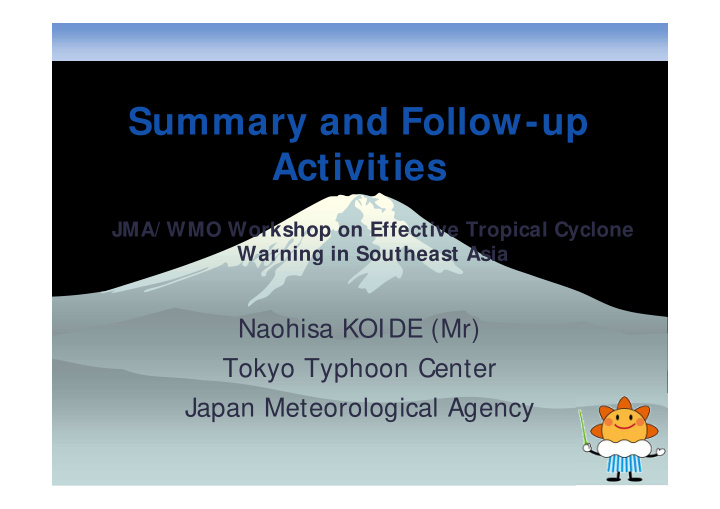



Summary and Follow-up Activities JMA/ WMO Workshop on Effective Tropical Cyclone Warning in Southeast Asia Naohisa KOIDE (Mr) Tokyo Typhoon Center Japan Meteorological Agency
Objectives To promote understanding of participating countries on the latest tropical cyclone analysis/forecasting techniques and products. To identify challenges of those countries in improving their operational forecasting and warning services. To discuss ways to address the challenges including external assistance.
TC Genesis Current Status and Challenges All members monitor TC genesis with satellite and NWP data. JTWC and NHC provide sophisticated probabilistic TC genesis information, while RSMC Tokyo provides EDA. Follow-up activities enhance capacity of RSMC in probabilistic TC genesis forecasting provide more technical information and training on EDA
Tropical Depression Current Status and Challenges Southeast Asia is often affected by TDs, and need more capacity for TD information for effective warnings. Follow-up activities provide more technical assistance in weather radar techniques for radar composite, and QPE/QPF . Enhance regional cooperation among members in southeast Asia including promotion of radar data exchanges.
TC Analysis Current Status and Challenges Some members operationally use Dvorak. TC analysis for TCs, particularly in early developing stage, are difficult. Follow-up activities provide more training opportunities for TC analysis, including Dvorak and microwave interpretation. provide products of TC intensity estimation to Members ensure Member's receipt of satellite data from the next generation satellites.
TC Forecast Current Status and Challenges Most members issue TC track and/or intensity forecasts based on NWP products from other centers with reference to both RSMCs and JTWC forecasts. Need better NWP products. Follow-up activities enhance capacity of RSMC in TC track and intensity forecasts, and improve RSMC products. enhance JMA's GSM & ensemble products. provide to Members, deterministic/ensemble guidance/products from JMA and other major centers on a real-time basis.
TC Forecast Current Status and Challenges TC forecasts depend on personal skills. Enhancement of forecaster's skills in TC forecasts, including TC indirect affects, are necessary. JTWC and NHC provide well developed training for TC analysis/ forecasts. Follow-up activities further enhance training materials on TC forecasts, and increase training opportunity (e.g. RSMC training).
Storm Surge Current Status and Challenges Most Members issue storm surge forecasts based on storm surge models such as JMA models. Follow-up activities further enhance storm surge forecasts for TY committee members increase training opportunity on JMA's storm surge models for Members
Effective Warning Current Status and Challenges current warning capacity widely differs by Members. However, almost all members need more capacity for improvement of warning accuracy as well as knowhow on warning coordination particularly for setting of warning criteria. Follow-up activities Share, through training and/or workshop, lessons learnt and knowhow on development of warning messages and coordination for setting warning criteria.
Close cooperation with RSMC Honolulu, Miami, and JTWC is very important: exchanging our views on TC related techniques and operational RSMC services are beneficial. Continue to work closely with JICA.
Thank you for your attention
Recommend
More recommend